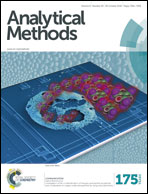Structure property studies revealed a new indoylfuranone based bifunctional chemosensor for Cu2+ and Al3+†
Abstract
The present report highlights the role of comprehensive structure property relationships (SPRs) in the discovery of a new and more effective molecular system for sensing purposes. From an extensive survey of different classes of amino substituted annulated furanones, it was realized that with some exceptions, these functionalized furanones could sense Cu2+ ions in the semi-aqueous phase irrespective of the nature of substituents; furthermore the same scaffolds could also detect Al3+, if the aldehydic position is specifically filled by a 3-indoyl group. As a result, amino substituted annulated furanones with 3-indoyl groups could detect both metal ions, response time of which mainly depends on the overall molecular framework. After replacing different furanone frameworks, a dual metal ion sensor (for Cu2+ and Al3+) with short response time and high selectivity and association constant was identified. The proposed bifunctional sensor displayed a distinct but observable response (turn off colorimetric for Cu2+ and turn on fluorescence for Al3+) to both metal ions with potential applications in the area of real sample analysis and membrane sensing.


 Please wait while we load your content...
Please wait while we load your content...